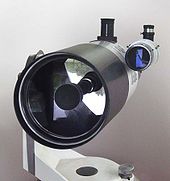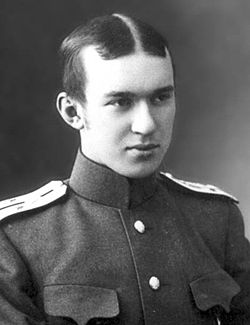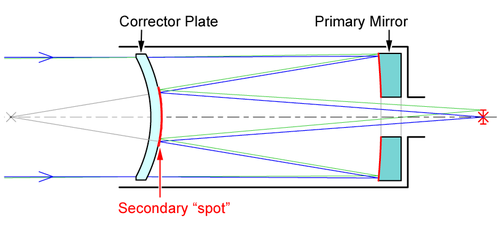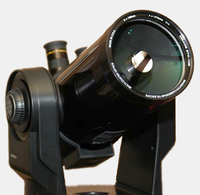
Maksutov telescope
Encyclopedia

Off-axis optical system
An off-axis optical system is an optical system in which the optical axis of the aperture is not coincident with the mechanical center of the aperture. An optical system in which the optical axis of the aperture is not coincident with the mechanical center of the aperture...
aberration
Aberration in optical systems
Aberrations are departures of the performance of an optical system from the predictions of paraxial optics. Aberration leads to blurring of the image produced by an image-forming optical system. It occurs when light from one point of an object after transmission through the system does not converge...
s such as coma
Coma (optics)
In optics , the coma in an optical system refers to aberration inherent to certain optical designs or due to imperfection in the lens or other components which results in off-axis point sources such as stars appearing distorted, appearing to have a tail like a comet...
found in reflecting telescope
Reflecting telescope
A reflecting telescope is an optical telescope which uses a single or combination of curved mirrors that reflect light and form an image. The reflecting telescope was invented in the 17th century as an alternative to the refracting telescope which, at that time, was a design that suffered from...
s while also correcting chromatic aberration
Chromatic aberration
In optics, chromatic aberration is a type of distortion in which there is a failure of a lens to focus all colors to the same convergence point. It occurs because lenses have a different refractive index for different wavelengths of light...
. It was patented in 1941 by Russian
Russians
The Russian people are an East Slavic ethnic group native to Russia, speaking the Russian language and primarily living in Russia and neighboring countries....
optician Dmitri Dmitrievich Maksutov
Dmitri Dmitrievich Maksutov
Dmitry Dmitrievich Maksutov was a Russian / Soviet optical engineer and amateur astronomer. He is best known as the inventor of the Maksutov telescope.-Biography:...
. Maksutov based his design on the idea behind the Schmidt camera
Schmidt camera
A Schmidt camera, also referred to as the Schmidt telescope, is a catadioptric astrophotographic telescope designed to provide wide fields of view with limited aberrations. Other similar designs are the Wright Camera and Lurie-Houghton telescope....
of using the spherical errors of a negative lens to correct the opposite errors in a spherical primary mirror
Primary mirror
A primary mirror is the principal light-gathering surface of a reflecting telescope.-Description:The primary mirror of a reflecting telescope is a spherical or parabolic shaped disks of polished reflective metal , or in later telescopes, glass or other material coated with a reflective layer...
. The design is most commonly seen in a Cassegrain
Cassegrain reflector
The Cassegrain reflector is a combination of a primary concave mirror and a secondary convex mirror, often used in optical telescopes and radio antennas....
variation, with an integrated secondary, that can use all-spherical elements, thereby simplifying fabrication. Maksutov telescopes have been sold on the amateur
Amateur astronomy
Amateur astronomy, also called backyard astronomy and stargazing, is a hobby whose participants enjoy watching the night sky , and the plethora of objects found in it, mainly with portable telescopes and binoculars...
market since the 1950s.
Invention

Primary mirror
A primary mirror is the principal light-gathering surface of a reflecting telescope.-Description:The primary mirror of a reflecting telescope is a spherical or parabolic shaped disks of polished reflective metal , or in later telescopes, glass or other material coated with a reflective layer...
in conjunction with a negative meniscus lens as far back as 1936. His notes from that time on the function of Mangin mirror
Mangin mirror
In optics, a Mangin mirror is a negative meniscus lens with the reflective surface on the rear side of the glass forming a curved mirror that reflects light without spherical aberration...
s, an early catadioptric spotlight
Searchlight
A searchlight is an apparatus that combines a bright light source with some form of curved reflector or other optics to project a powerful beam of light of approximately parallel rays in a particular direction, usually constructed so that it can be swiveled about.-Military use:The Royal Navy used...
reflector consisting of negative lens with silvering on the back side, include a sketch of Mangin mirror with the mirror part and the negative lens separated into two elements. Maksutov seems to have picked up the idea again in 1941 war-torn Europe as a variation on an earlier design that paired a spherical mirror with a negative lens, Bernhard Schmidt
Bernhard Schmidt
Bernhard Woldemar Schmidt was a German optician. In 1930 he invented the Schmidt telescope which corrected for the optical errors of spherical aberration, coma, and astigmatism, making possible for the first time the construction of very large, wide-angled reflective cameras of short exposure time...
's 1931 "Schmidt Camera
Schmidt camera
A Schmidt camera, also referred to as the Schmidt telescope, is a catadioptric astrophotographic telescope designed to provide wide fields of view with limited aberrations. Other similar designs are the Wright Camera and Lurie-Houghton telescope....
". Maksutov claimed to have come up with the idea of replacing the complex Schmidt corrector plate
Schmidt corrector plate
A Schmidt corrector plate is an aspheric lens which is designed to correct the spherical aberration in the spherical primary mirror it is combined with. It was invented by Bernhard Schmidt in 1931, although it may have been independently invented by Finnish astronomer Yrjö Väisälä in 1924...
with an all-spherical "meniscus corrector plate" while riding in a train of refugees from Leningrad. Maksutov is described as patenting his design in May, August, or October 1941 and building a "Maksutov–Gregorian
Gregorian telescope
The Gregorian telescope is a type of reflecting telescope designed by Scottish mathematician and astronomer James Gregory in the 17th century, and first built in 1673 by Robert Hooke...
"-style prototype in October 1941. Maksutov came up with the unique idea using an "achromatic corrector", a corrector made of a single type of glass with a weak negative meniscus shape that departed from the pure concentric spherical symmetrical shape to correct chromatic aberration.
Similar independent meniscus telescope designs were also patented in 1941:
Albert Bouwers
Albert Bouwers
Albert A. Bouwers was a Dutch optical engineer. He is known for developing and working with X-Rays and various optical technologies as a high-level researcher at Philips research labs...
(his 1941 concentric meniscus telescope), K. Penning and Dennis Gabor
Dennis Gabor
Dennis Gabor CBE, FRS was a Hungarian-British electrical engineer and inventor, most notable for inventing holography, for which he later received the 1971 Nobel Prize in Physics....
(a catadioptric non-monocentric design). Wartime secrecy kept these inventors from knowing about each other's designs, leading to each being an independent invention.
Derivative designs
Maksutov's design for a meniscus telescope was the first to be published, appearing in the Journal of the Optical Society of AmericaJournal of the Optical Society of America
The Journal of the Optical Society of America was founded in 1917 and is a scientific journal of the Optical Society of America. It was split into the Journal of the Optical Society of America A and the Journal of the Optical Society of America B in 1984, with JOSSA covering various topics in...
Vol. 34, No. 5. in May 1944 in a paper written by Maksutov entitled New Catadioptric Meniscus Systems. This led to professional and amateur designers almost immediately experimenting with variations, including Newtonian
Newtonian telescope
The Newtonian telescope is a type of reflecting telescope invented by the British scientist Sir Isaac Newton , using a concave primary mirror and a flat diagonal secondary mirror. Newton’s first reflecting telescope was completed in 1668 and is the earliest known functional reflecting telescope...
, Cassegrain
Cassegrain reflector
The Cassegrain reflector is a combination of a primary concave mirror and a secondary convex mirror, often used in optical telescopes and radio antennas....
, and wide-field camera designs.
Maksutov–Cassegrains
There are many Maksutov designs that use a CassegrainCassegrain reflector
The Cassegrain reflector is a combination of a primary concave mirror and a secondary convex mirror, often used in optical telescopes and radio antennas....
configuration, mounting a convex secondary mirror
Secondary mirror
A secondary mirror is the second deflecting or focusing mirror element in a reflecting telescope. Light gathered by the primary mirror is directed towards a focal point typically past the location of the secondary. Secondary mirrors in the form of an optically flat diagonal mirror are used to...
near the focus of the primary mirror
Primary mirror
A primary mirror is the principal light-gathering surface of a reflecting telescope.-Description:The primary mirror of a reflecting telescope is a spherical or parabolic shaped disks of polished reflective metal , or in later telescopes, glass or other material coated with a reflective layer...
. Most types use full-aperture correctors and are therefore not very large, since the corrector plate rapidly becomes prohibitively large, heavy and expensive as the aperture increases, with very long cool-down times to reach optimal optical performance. Most commercial manufacturers usually stop at 180 mm (7 in).
Gregory or "Spot" Maksutov-Cassegrains

Cassegrain reflector
The Cassegrain reflector is a combination of a primary concave mirror and a secondary convex mirror, often used in optical telescopes and radio antennas....
-type construction with a secondary silvered "spot" on the convex side of the meniscus facing the primary mirror
Primary mirror
A primary mirror is the principal light-gathering surface of a reflecting telescope.-Description:The primary mirror of a reflecting telescope is a spherical or parabolic shaped disks of polished reflective metal , or in later telescopes, glass or other material coated with a reflective layer...
. He thought this would create a sealed and rugged optical system suitable for use in schools. This design appeared commercially in Lawrence Braymer's 1954 Questar telescope and in Perkin–Elmer designer John Gregory
John F. Gregory
John F. Gregory was an American optical engineer and a popularizer of amateur telescope making. He is credited with the design of a version of the Maksutov telescope called the "Gregory-Maksutov telescope".-Career:...
's competing patent for a Maksutov–Cassegrain. Commercial use of Gregory's design was explicitly reserved for Perkin–Elmer but was published as an amateur telescope
Amateur telescope making
Amateur telescope making is the activity of building telescopes as a hobby, as opposed to being a paid professional. Amateur telescope makers build their instruments for personal enjoyment of a technical challenge, as a way to obtain an inexpensive or personally customized telescope, or as a...
design in a 1957 issue of Sky and Telescope in a and variation. Most Maksutovs manufactured today are this type of 'Cassegrain' design (called either a "Gregory–Maksutov" or "Spot-Maksutov") that use all-spherical surfaces and have, as secondary, a small aluminized spot on the inner face of the corrector. This has the advantage of simplifying construction. It also has the advantage of fixing the alignment of the secondary and eliminates the need for a 'spider' that would cause diffraction spikes. The disadvantage is that, if all spherical surfaces are used, such systems have to have focal ratios above to avoid aberrations. Also, a degree of freedom in correcting the optical system by changing the radius of curvature of the secondary is lost, since that radius is the same as that of the rear meniscus face. Gregory himself, in a second, faster design, resorted to aspherization of the front corrector surface (or the primary mirror) in order to reduce aberrations. This has led to other designs with aspheric or additional elements to further reduce off-axis aberration. This type of Maksutov-Cassegrain's high focal ratio and narrower field of view makes them more suitable for lunar
Moon
The Moon is Earth's only known natural satellite,There are a number of near-Earth asteroids including 3753 Cruithne that are co-orbital with Earth: their orbits bring them close to Earth for periods of time but then alter in the long term . These are quasi-satellites and not true moons. For more...
and planet
Planet
A planet is a celestial body orbiting a star or stellar remnant that is massive enough to be rounded by its own gravity, is not massive enough to cause thermonuclear fusion, and has cleared its neighbouring region of planetesimals.The term planet is ancient, with ties to history, science,...
ary imaging and any other type of observing where a narrow field high power view is a plus, such as resolving tightly packed globular clusters and double stars.

Mass production
Mass production is the production of large amounts of standardized products, including and especially on assembly lines...
models by some of the major commercial manufacturers. More recently, low-cost Russian and, lately, Chinese mass-production has pushed the prices down even further. Many manufacturers currently produce Maksutov–Cassegrains, such as Explore Scientific
Explore Scientific
Explore Scientific is a company founded by former Meade Instruments Vice President of Brand Community Scott W. Roberts in 2008 and owned by Chinese manufacturer Jinghua Optical Electronics Co., Ltd. . Headquartered in Bentonville, Arkansas, the company designs and manufactures telescopes, spotting...
, Intes, and Intes-Micro, LOMO
LOMO
LOMO or Leningrad Optical Mechanical Amalgamation is a manufacturer of advanced optical instruments, medical equipment, consumer still and movie cameras, projectors, lenses, film editors, splicers, professional sound recorders for motion-picture production based in St. Petersburg, Russia...
, Synta Technology Corp, Orion Optics
Orion Optics
For the unrelated North American telescope retailer, go to Orion Telescopes & BinocularsOrion Optics is a telescope manufacturer in Crewe, England in the United Kingdom. They produce a wide range of Newtonian reflectors and advanced Maksutov catadioptric telescopes.A family run firm, Orion Optics...
, Telescope Engineering Company (TEC), Vixen
Vixen (telescopes)
Vixen is a Japanese company that makes telescopes, binoculars, spotting scopes and accessories for their products.Among many other more mainstream products they have created two unusual varieties of catadioptric telescopes with an open tube design instead of the full-aperture corrector plate of the...
, Celestron
Celestron
Celestron is a company that manufactures and imports telescopes, binoculars, spotting scopes, microscopes, and accessories for their products.-Origins and History:...
's C90 and C130 lines, and Meade Instruments's ETX
Meade ETX telescope
The ETX is a line of telescopes made by Meade Instruments.-Origins:The ETX started out as a line of Maksutov-Cassegrain telescopes by Meade...
line.
The spot Maksutov–Cassegrain design has been used extensively in military
Military
A military is an organization authorized by its greater society to use lethal force, usually including use of weapons, in defending its country by combating actual or perceived threats. The military may have additional functions of use to its greater society, such as advancing a political agenda e.g...
, industrial
Industry
Industry refers to the production of an economic good or service within an economy.-Industrial sectors:There are four key industrial economic sectors: the primary sector, largely raw material extraction industries such as mining and farming; the secondary sector, involving refining, construction,...
, and aerospace
Aerospace
Aerospace comprises the atmosphere of Earth and surrounding space. Typically the term is used to refer to the industry that researches, designs, manufactures, operates, and maintains vehicles moving through air and space...
applications. Since all of the optical elements can be permanently fixed in alignment and the tube assembly can be environmentally sealed, the design is extremely rugged. That makes them ideal for tracking, remote viewing, and radar calibration/boresight
Boresight
Boresight is a term used to describe crude adjustments made to an optical firearm sight, or iron sights, to align the firearm barrel and sights. This method is usually used to pre-align the sights, which makes zeroing much faster.Traditional boresighting, as the name suggests involves removing...
ing where instruments are subjected to severe environments and high g-force
G-force
The g-force associated with an object is its acceleration relative to free-fall. This acceleration experienced by an object is due to the vector sum of non-gravitational forces acting on an object free to move. The accelerations that are not produced by gravity are termed proper accelerations, and...
s.
Rutten Maksutov-Cassegrains
The Rutten Maksutov–Cassegrain (also called a Rumak or Sigler Maksutov) has a separate secondary mirror mounted on back of the meniscus corrector, sometimes similar to the corrector/mirror holder configurations found in commercial Schmidt–Cassegrains. This provides an extra degree of freedom in correcting aberration by changing the curvature of the corrector and the secondary independently.Specifically it allows the designer to aspherize the secondary to provide a much wider flat field than traditional spot Maksutovs, with less off-axis coma. Mounting the secondary on the corrector also limits diffraction spikes. This version is named after the work of Dutch optical designer Harrie Rutten.
Sub-aperture corrector Maksutov-Cassegrains
Maksutov noted in his designs that instead of using a full-aperture corrector, a small sub-aperture corrector could be placed in the converging light cone of the primary mirror and achieve the same effect. In the 1980s Dave Shafer and Ralph W. Field came out with sub-aperture Cassegrain designs based on this idea. The design saves on the mass and "cool-down time" of a full aperture corrector. It has the drawbacks of an open, unsealed tube and requires a spider assembly to hold the secondary mirror and corrector, which inevitably affects image quality through diffraction artifacts. Also since the light passes through the corrector twice, the number of surfaces involved is multiplied, making it difficult to achieve good aberration correction. Sub-aperture corrector Maksutovs are currently manufactured by Vixen telescopesVixen (telescopes)
Vixen is a Japanese company that makes telescopes, binoculars, spotting scopes and accessories for their products.Among many other more mainstream products they have created two unusual varieties of catadioptric telescopes with an open tube design instead of the full-aperture corrector plate of the...
, their VMC (Vixen Maksutov Cassegrain) models.
Maksutov Newtonians
Maksutovs optics can be used in NewtonianNewtonian telescope
The Newtonian telescope is a type of reflecting telescope invented by the British scientist Sir Isaac Newton , using a concave primary mirror and a flat diagonal secondary mirror. Newton’s first reflecting telescope was completed in 1668 and is the earliest known functional reflecting telescope...
configurations that have minimal aberration over a wide field of view
Field of view
The field of view is the extent of the observable world that is seen at any given moment....
, with one-fourth the coma of a similar standard Newtonian and one-half the coma of a Schmidt-Newtonian. Diffraction can also be minimized by using a high focal ratio with a proportionally small diagonal mirror mounted on the corrector, allowing this design to present contrast and image quality approaching that of unobstructed high-end refractors (although with some vignetting
Vignetting
In photography and optics, vignetting is a reduction of an image's brightness or saturation at the periphery compared to the image center. The word vignette, from the same root as vine, originally referred to a decorative border in a book. Later, the word came to be used for a photographic...
when used photographically). Like the Maksutov–Cassegrain, the size of the instrument is limited, due to the mass of the corrector plate.
Maksutov cameras
The Maksutov system can be used in a (rare) type of prime-focus ultra-wide-field astronomical camera design similar to the Schmidt cameraSchmidt camera
A Schmidt camera, also referred to as the Schmidt telescope, is a catadioptric astrophotographic telescope designed to provide wide fields of view with limited aberrations. Other similar designs are the Wright Camera and Lurie-Houghton telescope....
. Like the Schmidt camera, the Maksutov camera has a curved focal plane.

